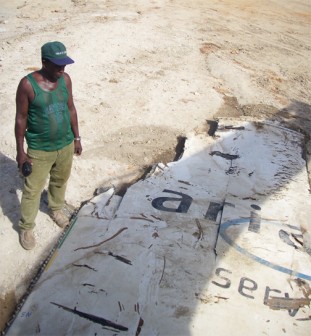Workers attached to a local dredging company at Mud Lot, Kingston on Saturday morning stumbled upon a piece of airframe debris, from the French Guiana-based, Ariane space agency.
Security guard Shadrock Tyson told Stabroek News yesterday that the piece of material, which measures approximately 15 feet in length by a width of 10 feet, washed up in the area early Saturday morning. He said that at first glance the material appeared to be a piece of zinc but closer examination revealed that pieces of sponge made up the walls of the debris.

Yesterday morning this newspaper visited the area and closer examination indicated that the debris carried several markings, which included ‘arian..’ , and ‘serv..’. Persons at the Guyana Civil Aviation Authority (GCAA) stated yesterday that it was unclear whether the agency received any word of the piece of material.
However, further checks by Stabroek News on internet websites revealed that the markings may be similar to those of the Ariane space agency in neighbouring French Guiana. The agency’s logo spells ‘arianespace’ followed by ‘service & solutions’. According to the company’s website, Arianespace offers launch services and solutions to satellite operators from around the world, both private companies and government agencies. The Arianespace family operates three spacecraft launchers the Ariane 5 heavy-lift launch vehicle, operated at the French Guiana Space Centre, the Soyuz medium launcher, which has been operated at Baikonur, Kazakhstan but will be operated at the French Guiana location starting in 2011, and the Vega light launcher, which will also be operated at the South America centre starting this year.
The Spaceport – another name given to the Guiana Space Centre is a strategically-located facility that provides optimum operating conditions for Arianespace’s commercial satellite launches, according to the company website.
The company stated that the Spaceport’s location close to the equator at 5.3 deg. North latitude makes it ideally-situated for missions into geostationary orbit. It was noted that launching near the equator reduces the energy required for orbit plane change manoeuvres. This saves fuel, enabling an increased operational lifetime for Ariane satellite payloads – and, in turn, an improved return on investment for the spacecraft operators. There had been other instances in the past when pieces of airframe debris as well as abandoned vessels washed up on Guyana’s coastline.




